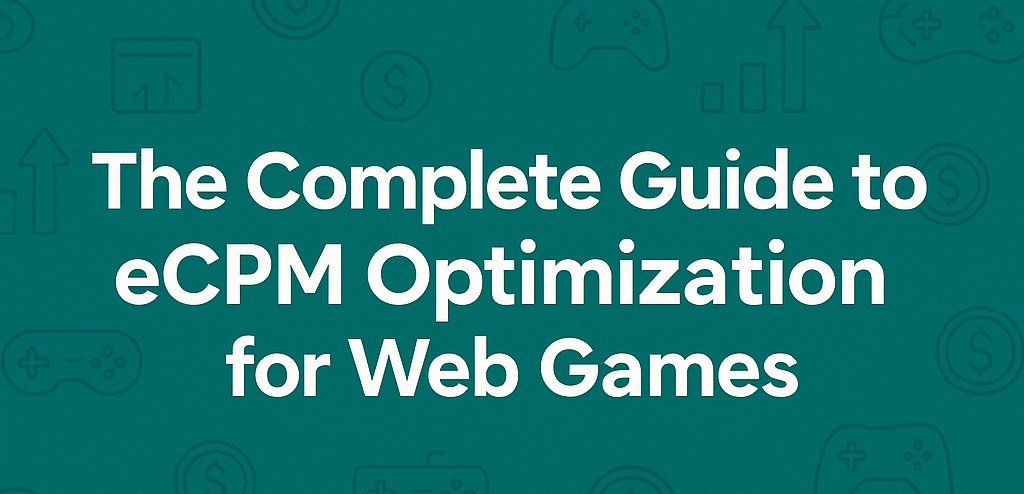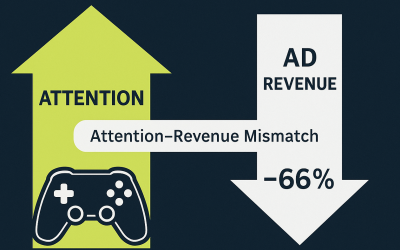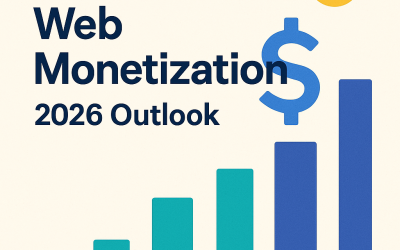The Complete Guide to eCPM Optimization for Web Games
Effective monetization of mobile and web games hinges on one critical metric: eCPM (effective cost per mille). This key performance indicator represents your ad revenue per thousand impressions and serves as the primary benchmark for measuring how well your ad inventory is monetized. Combined with strong fill rates—the percentage of ad requests actually filled with advertisements—a high eCPM translates directly into increased revenue per user.
For developers operating on a global scale through platforms like Google AdMob, optimizing eCPM requires a systematic approach that balances user experience with revenue generation. This comprehensive guide provides actionable strategies to diagnose low eCPM issues, improve fill rates, segment audiences effectively, and maximize your game’s monetization potential.
Contents
- 1 Understanding the eCPM Challenge
- 2 Diagnosing Performance Issues
- 3 Maximizing Fill Rates Through Strategic Mediation
- 4 Optimizing Ad Formats and Placement Strategy
- 5 Strategic Audience Segmentation
- 6 Enhancing User Experience Through Smart Creative Integration
- 7 Continuous Optimization and Performance Monitoring
- 8 Building Sustainable Revenue Growth
- 9 AppLixir Rewarded Video Ad Summary
Understanding the eCPM Challenge
Before implementing optimization strategies, it’s crucial to understand why eCPM performance might be underperforming. Low eCPM typically stems from several interconnected factors: poor ad placement that reduces user engagement, weak advertiser demand in certain geographic regions, improper configuration settings, or fundamental user experience issues that limit ad interaction.
The key to effective optimization lies in systematic diagnosis. Start by examining your core metrics in AdMob’s reporting dashboard: impressions, impression RPM (eCPM), click-through rate (CTR), match rate, and show rate. Each metric tells part of the story. A declining impression RPM might indicate that users are seeing ads but not engaging with them, suggesting either poor ad placement or relevance issues. Meanwhile, a low match rate—calculated as filled impressions divided by ad requests—signals fill rate problems that require immediate attention.
AdMob’s Insights dashboard serves as an early warning system, automatically detecting anomalies in revenue, eCPM, and impression volumes. These alerts help identify unusual drops or spikes that warrant investigation before they significantly impact your bottom line.
Diagnosing Performance Issues
 Effective eCPM optimization begins with thorough diagnosis. Examine your ad placement strategy critically—are your advertisements positioned where users naturally look and interact? Banner ads tucked into corners where users rarely glance will inevitably suffer from poor CTR, while interstitials that interrupt gameplay at inappropriate moments may cause users to abandon your game entirely.
Effective eCPM optimization begins with thorough diagnosis. Examine your ad placement strategy critically—are your advertisements positioned where users naturally look and interact? Banner ads tucked into corners where users rarely glance will inevitably suffer from poor CTR, while interstitials that interrupt gameplay at inappropriate moments may cause users to abandon your game entirely.
Geographic analysis reveals another common culprit. Since eCPMs vary dramatically by region—with the United States often achieving $13+ for rewarded video ads while many Latin American and Asian markets see only a few dollars—your overall performance might be diluted by traffic from lower-paying regions. Break down your performance by country to identify regional opportunities and challenges.
Technical factors also play a crucial role. Recent changes to your SDK integration, ad unit configurations, or placement modifications can introduce bugs or require stabilization time. Always verify that ads load properly using test configurations, and check AdMob’s Policy Center for any violations that might restrict ad serving.
Don’t overlook user behavior patterns either. Declining daily active users or shorter session lengths directly impact total impressions per user. Sometimes the issue isn’t ad performance but rather audience engagement—a high eCPM means little if impression volumes are low due to reduced user activity.
Maximizing Fill Rates Through Strategic Mediation
High fill rates ensure that virtually every ad opportunity in your game generates revenue rather than displaying empty ad slots. The foundation of strong fill rates lies in diversifying your demand sources through AdMob’s mediation platform.
Relying solely on Google’s ad network limits your potential. Even after Google’s transition to in-app bidding in 2024, third-party networks still account for 34-42% of mobile ad revenue. Integrating additional networks like Unity Ads, ironSource, or Meta Audience Network through AdMob mediation creates a competitive environment where the highest-paying network fills each impression.
Real-time bidding represents the next evolution in fill rate optimization. Enable AdMob’s Open Bidding feature to allow networks to compete simultaneously in auctions for each impression, rather than following a rigid waterfall hierarchy. This dynamic competition typically improves both fill rates and yield, as the highest bidder wins every impression in real-time.
For networks still operating in traditional mediation waterfalls, optimize their order and floor prices strategically. Consider implementing country-tiered floors: set higher minimum CPMs for Tier-1 countries like the US while using lower floors for Tier-3 countries to ensure ads can fill at appropriate regional price points.
Global coverage requires particular attention to regional demand patterns. While Google maintains a vast international advertiser base, certain geographies may benefit from local ad networks that fill impressions Google cannot serve effectively. Create country-specific mediation groups to plug in networks specializing in regions where AdMob’s fill rates are suboptimal.
Optimizing Ad Formats and Placement Strategy
Not all ad formats are created equal when it comes to revenue generation. Rewarded video ads consistently achieve the highest eCPMs—often 2x higher than interstitials—because users voluntarily opt-in for rewards and watch complete advertisements. Interstitial video and rich media ads also command premium rates, often reaching double-digit USD eCPMs in top markets.
Banner ads, while generating significantly lower eCPMs (sometimes just pennies in many regions), provide steady passive income due to their constant presence. The optimal strategy prioritizes high-value formats while using banners strategically to fill otherwise unused screen real estate.
Placement timing is equally critical. Display interstitials during natural gameplay breaks—between levels, after rounds, or at menu screens—never during active gameplay. Pre-load these ads to ensure instant display when triggered, and implement frequency caps to prevent ad fatigue.
Rewarded videos perform best when offered at points where users genuinely benefit from rewards: extra lives, bonus currency, or progress acceleration. Make the value exchange transparent and voluntary—”Watch an ad to receive 100 coins”—to achieve the high completion rates that drive premium eCPMs.
For banner advertisements, utilize adaptive formats that auto-size to devices and position them in visible yet unobtrusive locations. Successful implementations, like Nightingale Group’s adaptive banner tests, have achieved 200% eCPM increases with 99% fill rates while maintaining user retention.
Strategic Audience Segmentation
Effective monetization recognizes that not all users generate equal ad revenue. Geographic segmentation forms the foundation of this approach, dividing your global audience into tiers based on ad market value.
Tier-1 countries (US, Canada, Western Europe, Japan) justify aggressive monetization strategies with higher eCPM floors and premium ad formats, since advertisers pay substantially more for these audiences. A US interstitial averaging $10 eCPM supports more frequent ad serving or higher floor prices to maximize revenue per impression.
Tier-2 and Tier-3 regions require volume-focused approaches. Lower eCPM floors ensure impression fill even at reduced rates—$0.10 CPM generates more revenue than zero fill. These markets may benefit from banner-heavy strategies or region-specific ad networks that understand local advertiser behavior.
Platform segmentation reveals additional optimization opportunities. iOS versus Android users often exhibit different monetization patterns, with some networks paying premiums for specific platforms. Device performance segmentation allows high-end users to receive resource-intensive ad formats while ensuring low-end devices maintain smooth performance.
Behavioral segmentation considers user lifecycle stages. New players shouldn’t face aggressive ad monetization in their first sessions—focus on engagement initially, then gradually introduce ads as users demonstrate retention. Conversely, highly engaged non-paying users might tolerate more frequent ad serving, while paying users require careful balance to avoid cannibalizing purchase revenue.
Enhancing User Experience Through Smart Creative Integration
While publishers cannot directly control third-party ad creatives, you can significantly influence ad performance through strategic presentation and integration approaches.
Native ads represent the pinnacle of creative integration, allowing advertisements to match your game’s visual style and user interface. By controlling fonts, colors, and layouts, native ads feel like natural game content rather than disruptive elements. This seamless integration often improves user interaction rates, leading to higher CTRs and eCPMs.
For rewarded videos, the “creative” includes your reward offer presentation. Clear, enticing messaging—”Watch Ad for 50 Coins” with reward previews—dramatically increases uptake rates. Games like Subway Surfers demonstrate how explicit reward communication drives strong ad engagement.
Direct advertising campaigns offer premium creative control opportunities. Working directly with advertisers or using Google Ad Manager for exclusive placements commands high CPMs through custom integrations: branded character skins, sponsored events, or themed campaign content. These tailored campaigns often achieve fixed high eCPMs that elevate overall performance.
Continuous Optimization and Performance Monitoring
Sustainable eCPM optimization requires ongoing attention and systematic improvement processes. Monitor industry trends and seasonal patterns—advertiser demand fluctuates predictably, with Q4 holiday surges and Q1 declines. Plan monetization strategies around these cycles to maximize high-demand periods while maintaining realistic expectations during slower periods.
Implement comprehensive A/B testing for all significant changes. Test new ad networks on limited traffic segments before full deployment. Experiment with different floor prices, ad frequencies, and placement strategies using controlled user groups. AdMob’s Mediation Groups and Firebase Remote Config facilitate systematic testing that enables data-driven decisions rather than guesswork.
Maintain strict focus on user lifetime value (LTV) rather than short-term metrics. An optimization that increases today’s eCPM but causes user churn ultimately reduces long-term revenue. Track retention alongside ad revenue using metrics like ARPDAU (Ad Revenue Per Daily Active User) over 7 and 30-day periods to understand cumulative effects.
Technical performance remains fundamental to optimization success. Ensure ads don’t cause crashes, excessive memory usage, or page slowdowns that degrade user experience. Stay compliant with Google’s policies by regularly checking AdMob’s Policy Center for violations that could reduce demand or trigger suspensions.
Building Sustainable Revenue Growth
The ultimate goal of eCPM optimization extends beyond immediate revenue increases to building sustainable, long-term monetization that grows with your user base. Consider alternative monetization for segments that generate low ad revenue—cross-promotion to better-monetizing games, “remove ads” premium purchases, or conversion to in-app purchase behavior.
Stay current with ad technology evolution. Google frequently introduces new AdMob features, formats, and bidding partnerships. Early adoption of high-performing innovations can provide months of competitive advantage before widespread implementation.
Most importantly, maintain user experience as your primary consideration. Your ad revenue ultimately depends on player satisfaction and retention. Aggressive monetization that drives user exodus is far more damaging than temporary eCPM dips. The most successful games create monetization experiences where ads feel like fair exchanges for free gameplay rather than intrusive interruptions.
AppLixir Rewarded Video Ad Summary
eCPM optimization represents a complex but rewarding challenge that requires systematic diagnosis, strategic implementation, and continuous refinement. By understanding your performance metrics, diversifying demand sources, optimizing ad formats and placement, segmenting audiences strategically, and maintaining focus on user experience, you can build monetization systems that grow sustainably with your games.
Success comes from treating each impression and user session as valuable optimization opportunities. Through methodical application of these strategies—diagnosing issues with data, improving fill rates through mediation, focusing on high-yield ad formats, segmenting audiences for maximum value, and integrating ads seamlessly into gameplay—you can achieve significant improvements in eCPM, fill rate, and total ad earnings while preserving the player experience that drives long-term success.
Remember that effective monetization is an ongoing process requiring regular analysis, experimentation, and adaptation to changing market conditions. With consistent application of these proven techniques, your games can achieve sustainable revenue growth that supports continued development and user acquisition efforts.



